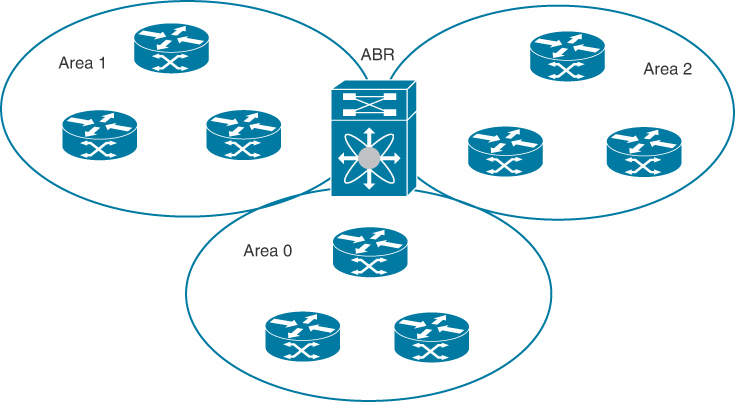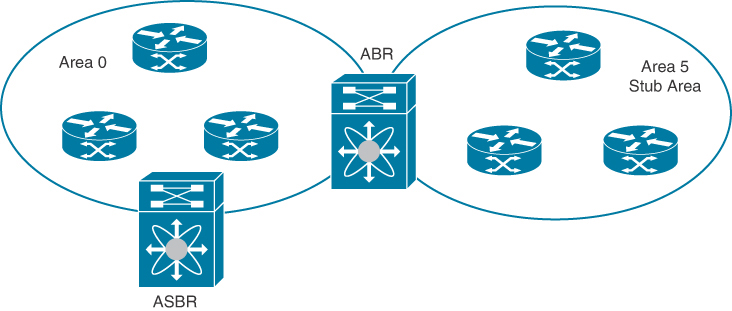An area is a logical division of routers and links within an OSPF domain that creates separate subdomains. LSA flooding is contained within an area, and the link-state database is limited to links within the area, which reduces the CPU and memory requirements for an OSPF-enabled router. You can assign an area ID to the interfaces within the defined area.
The area ID is a 32-bit value that you can enter as a number or in dotted-decimal notation, such as 3.3.3.3 or 0.0.0.3. Cisco NX-OS always displays the area in dotted-decimal notation. If you define more than one area in an OSPF network, you must also define the backbone area, which has the reserved area ID of 0.0.0.0. If you have more than one area, one or more routers become area border routers (ABRs). An ABR connects to both the backbone area and at least one other defined area (see Figure 1-1).

Figure 1-1 OSPF Areas
The ABR has a separate link-state database for each area to which it connects. The ABR sends Network Summary (type 3) LSAs from one connected area to the backbone area. The backbone area sends summarized information about one area to another area.
OSPF defines another router type as an autonomous system boundary router (ASBR). This router connects an OSPF area to another autonomous system. An autonomous system is a network controlled by a single technical administration entity. OSPF can redistribute its routing information into another autonomous system or receive redistributed routes from another autonomous system.
You can limit the amount of external routing information that floods an area by making it a stub area. A stub area is an area that does not allow AS External (type 5) LSAs. These LSAs are usually flooded throughout the local autonomous system to propagate external route information. Stub areas have the following requirements:
All routers in the stub area are stub routers.
No ASBR routers exist in the stub area.
You cannot configure virtual links in the stub area.
Figure 1-2 shows an example of an OSPF autonomous system where all routers in area 0.0.0.5 have to go through the ABR to reach external autonomous systems. Area 0.0.0.5 can be configured as a stub area.

Stub areas use a default route for all traffic that needs to go through the backbone area to the external autonomous system.
There is an option to allow OSPF to import autonomous system external routes within a stub area; this is a not-so-stubby area (NSSA). An NSSA is similar to a stub area, except that an NSSA allows you to import autonomous system (AS) external routes within an NSSA using redistribution. The NSSA ASBR redistributes these routes and generates NSSA External (type 7) LSAs that it floods throughout the NSSA. You can optionally configure the ABR that connects the NSSA to other areas to translate this NSSA External LSA to AS External (type 5) LSAs. The ABR then floods these AS External LSAs throughout the OSPF autonomous system. Summarization and filtering are supported during the translation.
You can, for example, use NSSA to simplify administration if you are connecting a central site using OSPF to a remote site that is using a different routing protocol. Before NSSA, the connection between the corporate site border router and a remote router could not be run as an OSPF stub area because routes for the remote site could not be redistributed into a stub area. With NSSA, you can extend OSPF to cover the remote connection by defining the area between the corporate router and remote router as an NSSA.